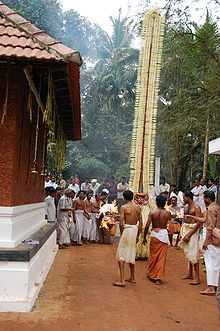Thirra


Thirra is a ritual dance performed in Bhagavati temples of the North Malabar region in Kerala State, South India. Thirra is performed primarily in the Thalassery and Vadakara areas. This art form is performed by the artists of Peruvannan (Vannan) community. This art is performed during Utsavam (annual temple festival). Clan deities such as Bhagavathi, Vishnu, Shiva are worshipped in these forms. It is similar to the Theyyam dance performed in the same region, except that in Theyyam the performer is considered as the god he is representing, while in Thiera the performer is considered as to be possessed by god.
Thirra brings the gods to life. Performers dress up with ceremonial facial paint and loud clothing and dance in front of the deity, the bhagwati. The objective clearly is to bring a sense of awe to the proceedings. Each performer represents a particular deity and is sponsored by devotees as a prayer offering. These dancers are viewed as being possessed by the gods when they are in their act, with devotees queuing up to meet them to share woes and wishes.
Toddy plays a very significant role in the proceedings, it is an offering to the gods and almost all the performers dance under the influence. This helps in creating the feeling of being "possessed". The performers belong to the "Malayan" caste of tribals, who are given prime importance in Thirra and Theyyam. Therefore in Kerala, both upper caste Brahmins, and lower caste tribals have an important place in worship.
Different types of Thiras
- Bhagavati Thirra
- Bhairavan Thirra
- Chanthu Thirra
- Gulikan Thirra
- Kuttichathan Thirra
- Hanuman Thirra
- Pottan Thirra
- Kandakarnan Thirra
- Chamundi Thirra
- Vasurimala Thirra
- NagaKali Thirra
- Dharikavadham Thirra
- Naga Kaali Thira
- Bhadra kaali Thira
- Raktheshwari Amma
- Kurumba Bhagawathi
References
External links
| |||||||||||||||||||||||||||||